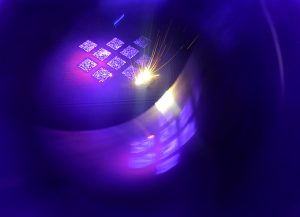VCSEL Process Developed by Fraunhofer ILT Reduces Stresses in Metal 3D Printed Components

The component preheated with VCSEL (right) has significantly less distortion than the component not preheated for the exposure process.
Fraunhofer Institute for Laser Technology (Fraunhofer ILT) is responsible for a great deal of research into 3D printing. The institute has developed technology that addresses common problems in metal additive manufacturing, created large-scale 3D printing solutions, and introduced hybrid 3D printing processes, just to name a few of its accomplishments. Now, as formnext 2018 approaches, Fraunhofer ILT is debuting another new technology.
 Internal stresses in metal 3D printed components produced by laser powder bed fusion are caused by temperature gradients. The part in the laser spot is heated to a temperature above the melting point, while the rest of the component cools rapidly. This can even lead to cracks in the part, depending on the geometry and material. To prevent this, the component is usually heated from below the build plate, but that isn’t always sufficient, especially with taller parts.
Internal stresses in metal 3D printed components produced by laser powder bed fusion are caused by temperature gradients. The part in the laser spot is heated to a temperature above the melting point, while the rest of the component cools rapidly. This can even lead to cracks in the part, depending on the geometry and material. To prevent this, the component is usually heated from below the build plate, but that isn’t always sufficient, especially with taller parts.
As part of the Digital Photonic Production DPP research campus, a funding initiative of the German Federal Ministry of Education and Research (BMBF), Fraunhofer ILT has been working with its partner Philips Photonics to develop a better solution. In a project called DPP Nano, they have developed a process in which the component is heated from above.
In the new process, an array of six vertical-cavity surface-emitting laser bars (VCSEL), 400W each, is installed in the process chamber. With infrared radiation at 808 nm, the array can heat the component to several hundred degrees Celsius during the building process. The bars can also be individually controlled to produce different patterns. The whole process is monitored with an infrared camera.
 In one experiment, engineers from Fraunhofer ILT 3D printed parts with Inconel 718, heating them up to 500°C. The parts showed significantly reduced distortion. The VCSEL heating reduces the thermal gradient and therefore the potential for stress, allowing taller components to be built. Fraunhofer ILT will soon be testing the process with more challenging materials, such as titanium alumides. These components will be heated to approximately 900ºC. Parts made from these materials are commonly used in the hot gas section of turbochargers.
In one experiment, engineers from Fraunhofer ILT 3D printed parts with Inconel 718, heating them up to 500°C. The parts showed significantly reduced distortion. The VCSEL heating reduces the thermal gradient and therefore the potential for stress, allowing taller components to be built. Fraunhofer ILT will soon be testing the process with more challenging materials, such as titanium alumides. These components will be heated to approximately 900ºC. Parts made from these materials are commonly used in the hot gas section of turbochargers.
The new process opens up possibilities for applications beyond turbomachinery, particularly in industrial sectors where thermally induced stresses have to be reduced.
Fraunhofer ILT is one of the most prominent institutions in the field of laser technology. It offers feasibility studies, process qualification and laser integration, and its activities include developing new laser beam sources and components, precise laser based metrology, testing technology and industrial laser processes. Founded more than 30 years ago, Fraunhofer ILT employs 500 people and has a net floor space of more than 19,500 meters squared.
Formnext is taking place in Frankfurt from November 13th to 16th, expecting 470 exhibitors and nearly 22,000 visitors. Fraunhofer ILT will be at Booth 370 and will be presenting and discussing the new VCSEL process. In addition, Fraunhofer’s Andreas Vogelpoth will give a presentation on “VCSEL-Based Preheating for LBPF” on November 15th at 3:00 PM.
Discuss this and other 3D printing topics at 3DPrintBoard.com or share your thoughts below.
[Source/Images: Fraunhofer ILT]
Subscribe to Our Email Newsletter
Stay up-to-date on all the latest news from the 3D printing industry and receive information and offers from third party vendors.
Print Services
You May Also Like
New Business: Temporary, Migratory, & Modular 3D Printed Architecture
If we look at potentially emerging 3D printing businesses, then architecture has not been fully explored. Yes, there is a lot of house 3D printing going on worldwide. From deployable...
3D Printing News Briefs, April 19, 2025: Material Extrusion Standard, Metal Powder, & More
In today’s 3D Printing News Briefs, we’re covering a proposed standard for material extrusion, before moving on to business and metal powder. We’ll end with a commercial store’s robotic 3D...
Japan Unveils World’s First 3D Printed Train Station
Japan is now home to what we believe is the world’s first train station built with 3D printing technology. Located in Arida City, just south of Osaka, the new Hatsushima...
restor3d Raises $38M to Expand 3D Printed Orthopedic Implants
Backed by $38 million in new funding, restor3d is pushing ahead with the launch of four personalized implant lines, set to roll out in 2025 and 2026. This latest venture...


























